Francesca and Henk-Jan's Backpacking Trip!
Saturday, March 27, 2010
It Only Gets Hotter Down South!
The first time on a sleeper-bus was surprisingly not a bad experience. Henk and I lucked out by getting assigned the very front top ‘bunks’ and as a result had extra space and leg-room. As we waited for departure, we explored our surroundings: two large nice blankets, two pillows, and snacks brought to us by the bus company. Not bad! Since we had taken the liberty of bringing our own food as well, this now meant we had a large stockpile in case the trip took longer than expected. We snacked on our food, tried to ignore the rocking of the bus, and watched a movie about the mysterious ‘Naga fireball’ called 'Mehkong Full Moon Party.'
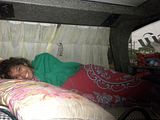
While the bunk was spacious for me, it was still on the small side for Henk. As a result, he was awake through the night while I was able to score some needed hours of sleep. Once we arrived in Pakse on March 21st, we caught a ride to the Phonsavan Guesthouse (we had told the driver the Phonsavan Hotel which is a different place, but this one turned out to be alright) where we immediately crashed and gained another few hours of sleep.
At around 1:30 PM we headed out to explore Pakse. Quite a small town, there wasn’t much to do and very quickly we had seen everything including an abandoned shopping mall that had been turned into a local market. We found a temple to explore and a great Indian (yes, again!) restaurant for dinner called Delicious butter chicken!


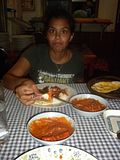
The next morning we were woken up by a knocking on our door. The previous day, Henk and I had been inquiring about a trip out to Wat Phu; a temple built by the Khmers before they went to Siem Reap and built Angkor Wat. The travel agent had come to us to inform us that we could go on the trip for the price we wanted, so we got ready to leave and met our group down at the agency’s office. We drove towards the ancient Wat, having to cross on a ferry part-way through the trip. Henk got out of the car to take some photos of the Laos fish-catching method, pointing out to me the fish flopping around in the water. He also went to buy me a bag of chips which he ended up purchasing from a cute little girl whose mother sent her over directly to Henk with (strangely enough!) the only bag of my favorite flavor. How did she know?
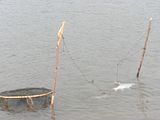
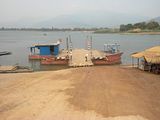
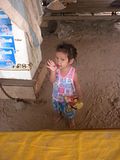
Anyways, we arrived at Wat Phu and WOW it was so hot in the south! Before we even reached the base of the temple we were covered in sweat. I held the little map/guidebook which explained to us this temple was built for worshipping the linga: a representation of the Hindu god Shiva – its ‘representation’ has commonly been thought of as ‘phallic representation’ but this idea is still debatable. I described the complex from the book as we walked through a pathway lined with lingas, and we started to see the main area of the temple which was under some heavy re-construction. Might be better to go in a couple years once it’s done!

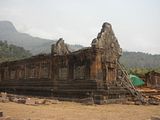
From the Wiki: “Wat Phu is a ruined Khmer temple complex in southern Laos. It is located at the base of mount Phu Kao, some 6 km from the Mekong river in Champasak province. There was a temple on the site as early as the 5th century, but the surviving structures date from the 11th to 13th centuries. The temple has a unique structure, in which the elements lead to a shrine where a linga was bathed in water from a mountain spring. The site later became a center of Theravada Buddhist worship, which it remains today.”
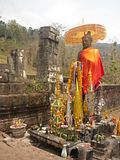
As we continued, we climbed and climbed. The complex was pretty large, but so much in shambles that it was difficult to picture the full design. At the top was a rock-face that dripped water – it was originally flowing with water -- which helped mark this place as a religious site. After visiting the temple, we spent some time in a museum which explained the divinities worshipped at the temple. Because they are some of the same ones we will talk about for Angkor Wat, I’ll leave the explanations until then.
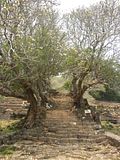
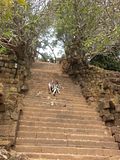
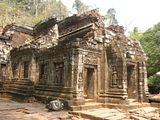
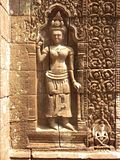
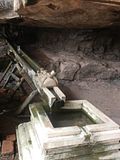
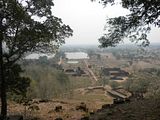
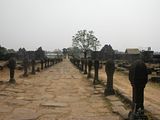
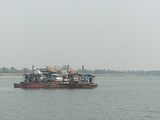
On the 23rd of March we planned to leave for 4000 islands. Henk ordered some tuna baguettes for us and feasted on noodle soup for breakfast while I finalized our trip arrangements down to Don Det, one of the 3 islands to choose from. Then we jumped in the bus and away we went! The ride down was pretty quick, only taking about 2 hours. Since we couldn’t really decide which island to jump off at even after tons of research, we ended up going with Don Det which was described as the ‘backpacker/party’ island. The island was supposedly connected to Don Khone which was slightly more expensive but calmer, and we thought we’d be able to travel in between the two quite easily.

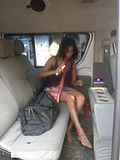
Well, 4000 islands was not really what we expected it to be at all! Don’t believe any of the information out there because most of it is pretty misleading. While the river was nice and the boat ride to the islands IS scenic, there was really no reason to stay on Don Det. It was virtually impossible with huge bags to get to Don Khone and we didn’t find Don Det very appealing at all – not even as a party destination! The whole island was covered in trash and seemed void of life despite the locals all running guesthouses or bars trying to make a few bucks. It was waaay too hot to lounge and relax outside and the river looked too nasty to swim or tube around in. Plus since the river was too low, no rafting was available, and while not very expensive the boat trips/fishing trips weren’t cheap either; there was a serious lack of competition being on such a small island. Perhaps Don Khong is nicer, but we heard it was even more expensive and still had the same scenery/activities… not worth our time!

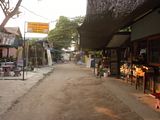
We found a cheap fan room at Mr Tho’s Bungalows, ate some Indian dinner (even on the smallest remote island in Asia there is still Indian food available!) and planned to leave for Kratie the next day. Let’s go to Cambodia!

It was quite a mission for us to get across the Laos/Cambodian border, despite the fact that we pre-arranged everything in advance. The company we booked our van through didn’t show up when they were supposed to, in fact they left without us, so we were told we’d be required to take motorcycle-taxis to the border. With our huge backpacks and other bags we jumped on them for a 30 minute ride to the border (which terrifies me because I’m freaked out by anything where I feel unstable like that) where we then saw four different groups of “passport stampers” waiting for us. Of course, we then had to pay ‘fees’ to all of them before our visas were issued and we got into our taxi for Kratie. However little did we know we wouldn’t be able to relax just yet… before the 4-5 hour drive to Kratie was over we had to change mini-vans 4 times due to drivers shuffling us around!
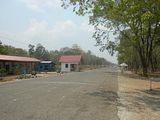
By the time we arrived in Kratie we were quite exhausted, finding a guesthouse (You Hong II) with some refreshing AC around 4:00 PM. Since we were out of cash we headed out to the ATM and explored town for a while before heading for dinner at Star Guesthouse’s downstairs cafe. We planned to see the famous Irrawaddy Dolphins the next morning.
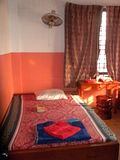
The dolphins are endangered and there are only a handful left in the Mekong River. Tourists are allowed to buy a boat ticket out to see them in order to raise money for their conservation. A little about the dolphins: Irrawaddy dolphins don’t have a traditional dolphin “beak” and instead have a high and round forehead. They communicate with ‘clicks’ and survive on a diet of boney fish and fish eggs. While they are found in Laos, the most common spot for them is actually in the waters around Bangladesh.
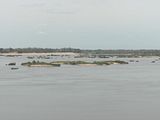
Here’s something interesting from the Wiki on how smart these dolphins are:
“In Myanmar, in the upper reaches of the Ayeyawady River, Irrawaddy dolphins drive fish towards fishers using cast nets in response to acoustic signals from them. In return, the Dolphins are rewarded with some of the fishers' by-catch. Historically, Irrawaddy River fishers claimed that particular dolphins were associated with individual fishing villages and chased fish into their nets. A 1879 report indicates that legal claims were frequently brought into native courts by fishers to recover a share of the fish from the nets of a rival fisher which the plaintiffs dolphin was claimed to have helped fill.”
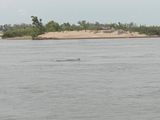
During the dry season the dolphins become confined to a few pools in the Mekong where they are easy to spot. However, since they usually don’t come above the water very far they are still extremely difficult to get a good picture of. In the hour we had on the boat we only managed to catch the back and a couple fins of the dolphins. But we found great pictures from professionals online to show you that fill the gap!

We finished before noon and were able to relax on some lounge chairs outside of Star where we ordered lunch and watched the locals doing their grocery shopping. One of the strange things we noticed about many Cambodian locals, especially the women and young children of both genders, is that they often dress in clothing that looks very close to Western ‘pajamas:’ loose, patterned with flowers or stripes, and complete with long sleeves, pants, and collars. Henk took a picture of one woman on a bike in pajamas. If anyone knows why they wear pajamas please let us know. We’ve asked locals but they don’t seem to understand what we’re talking about!
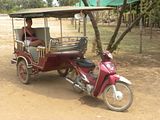
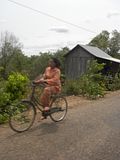
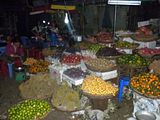
On the 27th of March we took the bus to Siem Reap to get ready for the grand Angkor Wat! Going by the Lonely Planet we found Shadow of Angkor II. While a bit pricey, the rooms are very nice and the room service extremely cheap! We were quite amazed to order two entrees, an appetizer, and drinks for just $10 USD to our room!! A luxury we have missed on this trip otherwise. Anyways, I’ll let Henk now tell you about our first days in Siem Reap!
Francesca
Sunday, March 21, 2010
A Pitstop At The Plain Of Jars In Phonsavan
Next, we went to talk to the tout that had taken us from the airport to town, Vongsavath of the Inter Lao Travel Agency. He offered us some standard Jars-tours, as well as one including a trip to a newer site that had only recently been opened. We decided to hold off on the decision for a while, whilst we explored the one street of Phonsavan. We had read about the large number of bombs and UXOs (Unexploded Ordnance) that were dropped by the Americans during the Secret War. Seeing them standing around as decoration, however, made it apparent just how abundant these remnants of war are.
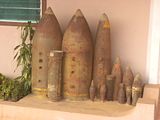
Francesca and I headed over to the UXO Information Center where the full extent of the Secret War became apparent to us. Xieng Khouang, the province we were in, was covered in 1.3 million ton of ordnance between 1964 and 1973. Up to 30% of some of the different types did not explode, still killing people across the province. Northern Laos was bombed because large areas were controlled by the Pathet Lao, the communist regime at the time which supported Communist Vietnam; Southern Laos was bombed mainly to disrupt use of the Ho Chi Minh trail, which was used by the Vietnamese to smuggle goods and equipment from North to South Vietnam. In total, there are still hundreds of thousands of UXOs covering the country.
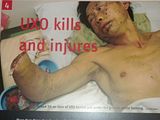
Since the war ended there have been over 50,000 recorded deaths due to UXOs. Furthermore, countless people lost limbs and were disabled for life. Almost half of the victims are children, who might see the bombs as toys or food. We saw some gruesome pictures of the harsh reality that is daily life on the countryside here. Francesca and I were also amazed how little the Americans have taken responsibility for their actions, as we found most of the UXO-clearing is funded by humanitarian organizations and countries that had nothing to do with the Secret War (amongst them almost everywhere the Dutch!). A British organization called MAG has even set up teams of local tribes’ people that have been trained to be expert bomb removers. We finished the impressive visit by watching the documentary ‘Bombies,’ which shows the aforementioned in every detail. Shocking to see!
We returned to the travel agency and booked the Plain of Jars tour for the next day, and had Indian (yes, again!) at the local Nisha restaurant. So good! We headed back around the corner to the White Orchid and slept in our comfy room.
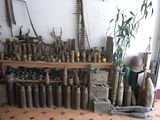
The next day we woke up around 8:00 AM for our free breakfast, which consisted of a baguette, an omelet and a cup of tea. We took our time and went to the office of the travel agency just before 9:00 AM. We were met by Tuwi, Vong’s brother and soon started our tour.
There’s over 50 different sites with jars, but only a few of them have been cleared of UXOs, so the options are fairly limited. It’s also the reason why the Plain of Jars is not yet a World Heritage Site. The MAG is working on clearing some of the more spectacular sites, but they’re obviously more interested in helping the people of the countryside out, since they’re the ones that have to work their paddies every day, risking their lives every day. Francesca and I realized the two-fold problem this presents: helping to clear the Plain of Jars will up tourism, improving life; cleaning the farms of UXOs makes life for the villagers safer, ups their production and will in the long run also improve their lives. Not an easy choice to make, so MAG divides its attention.
We started our trip to the Plain of Jars with a visit to the information center, where we had a look at some scrap from the war, ranging from small ‘bombies’ to giant fuel tanks from planes. We then drove to Site Two, which consists of 2 hills with a total of about 90 jars. When we heard ‘cleared of UXOs’ we didn’t think there’d only be a pathway to the jars, which we HAD to stay in between. When we got to the top of the first hill we spotted the first jars and Tuwi started explaining a little about the history of the jars. As the Lonely Planet summarizes: “The purpose of these possibly 2000-year-old jars remains a mystery and without any organic material – such as bones or food remains – there is no reliable way to date them. Archeological theories and local myth suggest the enigmatic jars were used for burial purposes – as stone coffins or urns – or maybe for storing Lao-Lao (rice whiskey) or rice.“
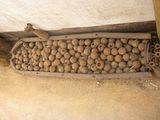
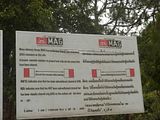
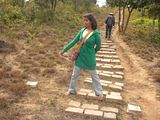
Francesca and I started thinking about the puzzle and came up with the idea they had some religious purpose, but we couldn’t quite figure out what they were used for. Burial seems unlikely since they haven’t found any bones, other than some found by a Frenchman in the 1930s which mysteriously disappeared. Storage also seems improbable since some of the jars were too big for me to reach in. Furthermore, we thought the people that made the jars must have had hides to store food in. Interesting nonetheless! We took some nice pictures with the pots, carefully looking around for any UXOs. We even saw one huge crater right next to a few of the jars, which meant the bunch around us got lucky!
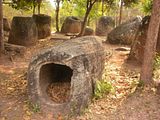
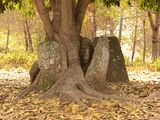
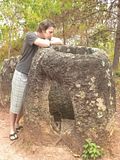

Tuwi took us to the second hill as well, and here we found more examples of the giant stone cookie jars. The highlight here was not a jar though: Tuwi showed us an old lid, once used to cover the contents under it. The top had an interesting carving of what might be a human figure. Standing on the hill we also noticed our hilly surroundings: very brown due to the dry season, but still very scenic. On our way back to the van we spotted a broken jar, which meant we could take a picture of the inside of the jar. Obviously Francesca climbed in the jar, careful not to damage anything, and I took a few cute pictures of her!
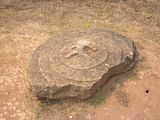
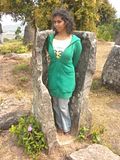
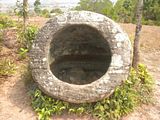
Our second jar site of the day was the newly opened and thus UXO-free site 16. It took quite a while to drive out there on the dusty and bumpy roads, but it proved to be worth it. Unlike the jars at site 2, which are made of sandstone, these jars were cut out of granite. The surroundings were also a little different, with there being a bunch more trees around. We had a look around, checking the contents of the jars, and realizing the only difference with site one was the absence of rubbish. Most jars here actually looked a little more ruined, and were actually not much more special than the other 90 we had already seen. What made the visit worth it became apparent in the final jar we checked… It contained a dead cat! Francesca wanted loads of pictures, so for those a little faint of heart: please ignore the following picture.
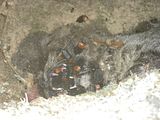
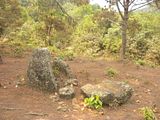
After kicking up a bit of sandstorm on our way down from site 16 we headed to Meuang Khoun, the old capital of the region. We had hoped for a more spectacular view, so just seeing one old Buddha was a bit disappointing. The temple, Wat Phia Wat, was bombed during the war and whilst the temple itself was destroyed the Buddha remained largely intact. Some shrapnel had damaged the face and some part of the left arm, but otherwise it looked in mint condition. I took some close-up pictures of the face before we headed for lunch.
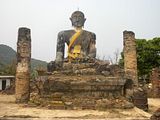
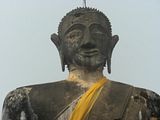
Lunch was served in a local restaurant by the side of the road. Pho (noodle soup) is a Laotian’s breakfast and lunch favorite, so Francesca and I got the chicken and duck Poh respectively. It came with a large plate of lettuce and mint leaves, as well as a tasty peanut sauce. On top of that we got a bunch of bananas to eat with it! The food got us re-energized and we left for our next stop.
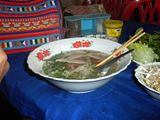
The That Found Stupa was built during the 14th century by a local king as a funeral shrine. On a small hill opposing his hill another Stupa can be found for his wife. When the kingdom fell and the Vietnamese came upon the Stupa they thought they might find great treasure under the massive stone structure, so they made an entire tunnel through the Stupa. They also made several large openings on the side, but to no avail: the Stupa was empty. Many centuries later the Stupa is now covered in grass and looks quite unique compared to many other Stupas we have seen on our travels.
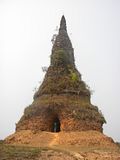
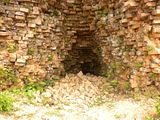
Our tour also included some visits to villages along the way. We made a short stop at Phouan village, inhabited by Lao Loum people, as well as Hmongs. These people have found creative ways of using the UXOs to their advantage: the village smith makes all sorts of tools out of the shrapnel, and the bombs are used as lamps or as extra support for their houses. We also visited the Thai Dam (Black Thai) village, where the locals still make most of their money through weaving. We learned that a proficient weaver can make about a meter and a half per 6 hours, which can then be sold for between US $6 and $10. The girls work from sunrise to sunset, with only a short 30 minute break for lunch. You don’t need to be a genius to figure out that that’s pretty poor pay for a lot of work! I felt bad about not buying anything, but at this point our backpacks are still of an acceptable weight and we want to keep it that way.
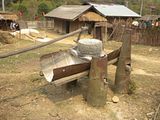
Around 2:20 PM we reach our final destination for the day: site 1, the biggest site of all with 334 jars. It’s also home to the largest jar of them all, which has a diameter of 2.5 meters and is 2.57 meters high. We walked uphill to the first cluster of jars and took more pictures. Signs around us made us aware of the old trench lines used during the war. In the distance we could also see a large selection of more jars. We walked downhill towards them, passing several craters along the way. Tuwi first took us into a large cave which was used as a shelter by the locals during the war. Old water tanks can still be seen on the floor, even though the years have caught up with them and they’re now covered in rust and dirt.

We headed back outside and walked towards our final selection of jars. Some had filled up so far with dirt that there were now plants growing out of them. Others still had stagnant, smelly pools of water in them. Others had broken altogether, and looked like piles of rubble. Tuwi showed us a special jar here, with a drawing of a human on it. It’s the only jar out of the many hundreds in the region that has any form of drawing on it. It’s uncertain why this jar has the art on it, but researchers guess it might just have been the sculptor who wanted to add a little extra to his creation. Tuwi also showed us another lid, which had been put on top of a jar by some local kids years ago. They’d put the lid on the wrong way around, which shows how the bottom of the lid has multiple rings on it. The rings were used for jars of different sizes, making the lids multi-functional. Smart!
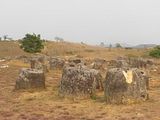
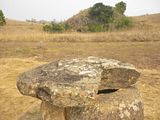
Our jar-time was drawing to an end since we didn’t want to stay until sunset (which the tour promised it would show us), which was still 3 hours away. We were both pissed off that we hadn’t done the entire itinerary, and were unpleasantly surprised to hear we’d just be dropped off at site 1 to wait for sunset and then be picked up 3 hours later. Not the best way to impress your customers! We headed back to the car, whilst Tuwi told us why some of the craters have extra smaller craters in the middle of them: locals had come in and tried to dig up any remaining shrapnel to sell for cash. Not without danger since parts of the cluster bombs could go off when hit by shovels or when stepped on.
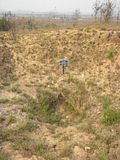
We headed back to town and tried to talk to Vongsavath, but he had mysteriously disappeared. When we asked when he’d come back we just heard he’d be back ‘later’. We decided to go for dinner first, and found a nice little restaurant called ‘Craters’ with both Laotian fair and Western food. We got takeaway, me opting for the chicken laap and Francesca bringing back a chicken fillet. We had to wait a long time for our food to arrive, which then turned out to be very small portions. On top of that they didn’t taste fantastic. Francesca fillet was the flattest of patties, hard to chew and her fries were soggy. My laap was decent, but the rice was old and the pieces of chicken few and far between.
The morning of the 19th Francesca and I tried to get in touch with Vongsavath again, but he’d just gone to the hairdressers, and then to the airport… We realized we wouldn’t see him anymore. Instead we decided to go for Indian at the local Nisha, where a Chicken Tikka Masala and Chicken Palak were a welcome replacement for last night’s culinary disaster. We found a tuk-tuk to take us to the airport and left Phonsavan around 3 PM, returning to Vientiane 30 minutes later.
We contemplated leaving that same evening to go to Pakse in the south of Laos, but we didn’t have enough time to book a ticket. We checked in for one more night at the Lakeo Belle Villa and slept like babies, before waking up on the 21st to buy tickets to Pakse. We knew this drive would take about 12 hours, and that there’d be sleeper buses available so we headed to the center of Vientiane and looked for travel agencies. Unfortunately, on Sundays they are all closed… Unsure of what to do we walked into the JoMa Bakery to share a banana split and order some sandwiches to bring back. We had heard we could just wing it and go to the bus station by ourselves. As we went to find a tuk-tuk to take us back we spotted a travel agency that was open! And it sold tickets to Pakse! We booked our tickets for later that evening, headed back to Lakeo and relaxed for a few hours before we were picked up. Francesca will tell you all about the sleeper bus and our adventures in the south!
